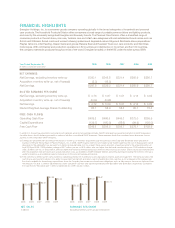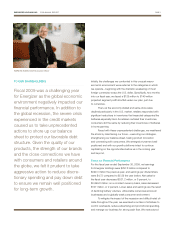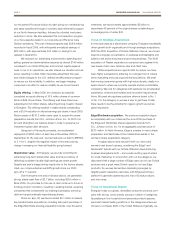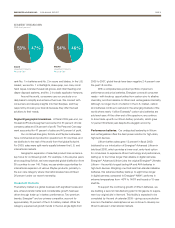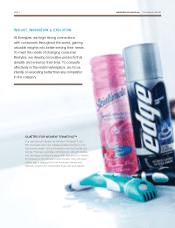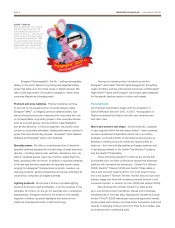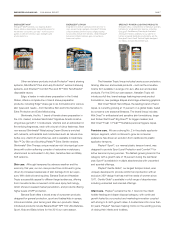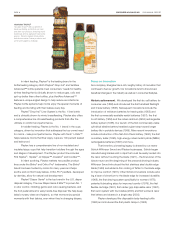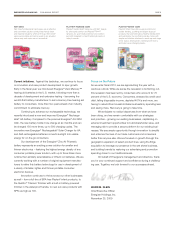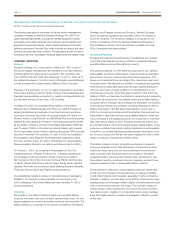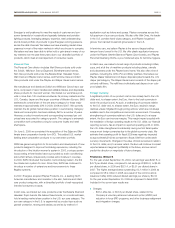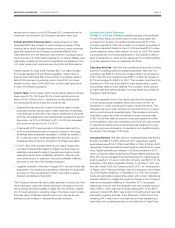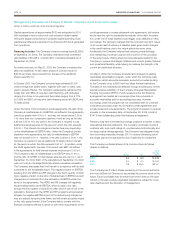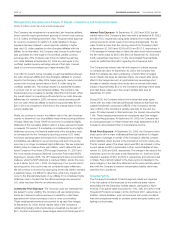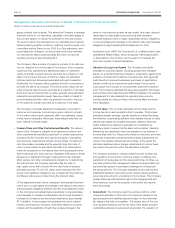Energizer 2009 Annual Report Download - page 12
Download and view the complete annual report
Please find page 12 of the 2009 Energizer annual report below. You can navigate through the pages in the report by either clicking on the pages listed below, or by using the keyword search tool below to find specific information within the annual report.
Management’s Discussion and Analysis of Results of Operations and Financial Condition
(Dollars in millions, except per share and percentage data)
PAGE 10 ENERGIZER HOLDINGS INC. 2009 ANNUAL REPORT
The following discussion is a summary of the key factors management
considers necessary in reviewing Energizer Holdings, Inc.’s (the Com-
pany) historical basis results of operations, operating segment results,
and liquidity and capital resources. The Company reports results in two
segments: Household Products, which includes batteries and portable
lighting products and Personal Care, which includes wet shave, skin care,
feminine care and infant care products. This discussion should be read in
conjunction with the Consolidated Financial Statements and related notes.
COMPANY OVERVIEW
General
Energizer Holdings, Inc., incorporated in Missouri in 1999, is one of
the world’s largest manufacturers and marketers of primary batteries,
portable lighting and personal care products in the wet shave, skin
care, feminine care and infant care categories. On April 1, 2000, all of
the outstanding shares of common stock of Energizer were distributed
in a tax-free spin-off to shareholders of Ralston Purina Company.
Energizer is the successor to over 100 years of expertise in the battery
and portable lighting products industry. Its brand names Eveready and
Energizer have worldwide recognition for quality and dependability, and
are marketed and sold in more than 165 countries.
On March 28, 2003, we completed the acquisition of the Schick-
Wilkinson Sword (SWS) business from Pfizer, Inc. SWS is the second
largest manufacturer and marketer of men’s and women’s wet shave
products in the world. Its portfolio of products include: the Quattro for
Women, Intuition, Lady Protector and Silk Effects Plus women’s shaving
systems and the Quattro and Protector men’s shaving systems, as well
as the Quattro, Xtreme 3, and Slim Twin/Exacta disposables. SWS has
over 75 years of history in the shaving products industry with a reputa-
tion for high quality and innovation in shaving technology. SWS products
are sold in more than 140 countries. On June 5, 2009, we completed
the acquisition of the Edge and Skintimate shave preparation brands
from S.C. Johnson & Son, Inc. (SCJ). This added U.S. market leading
shave preparation brands to our existing wet shave product portfolio.
On October 1, 2007, we completed the acquisition of all of the
outstanding stock of Playtex Products, Inc., a leading manufacturer
and marketer of well-recognized branded consumer products in
North America. Its portfolio of products include Playtex feminine care
products, Playtex infant care products, Diaper Genie diaper disposal
systems, Wet Ones pre-moistened wipes, Banana Boat and Hawaiian
Tropic sun care products, and Playtex household gloves.
Our subsidiaries operate a number of manufacturing and packaging
facilities in 14 countries on five continents, and we employ over
4,500 colleagues in the United States and approximately 11,000 in
foreign jurisdictions.
Industries
We operate in five distinct industries: battery and portable lighting
products, wet shave, skin care, feminine care and infant care. Our two
largest categories by revenue are battery products and wet shave. The
battery category is comprised of two primary competitors, Energizer’s
Eveready and Energizer brands and Procter & Gamble’s Duracell,
which we estimate represent approximately 70% in the markets in
which we compete. The wet shave category is comprised of two
primary competitors, Procter & Gamble’s Gillette and Energizer’s
Schick-Wilkinson Sword, which we estimate represent more than
80% of the global wet shave market.
Household Products
Energizer’s Household products division manufactures and markets
one of the most extensive product portfolios in household batteries,
specialty batteries and portable lighting products.
In household batteries, we offer batteries using carbon zinc, alkaline,
rechargeable and lithium technologies. These products are marketed
and sold into the price, premium and performance segments. This
allows us to penetrate the broad range of the market and meet most
consumer needs. We distribute our portfolio of household and specialty
batteries and portable lighting products through a global distribution
network, which also provides a platform for the distribution of our
personal care products. Since Energizer’s invention of the first D cell
battery in 1893, we have been committed to developing and marketing
innovative new products for the portable power and portable lighting
products market. Energizer has continued this dedication to innovation
by introducing multiple new products, including extending our lithium
battery technology to the first lithium AAA battery in 2003, and, in
2008, by introducing the Advanced Lithium battery that performs four
times better in high drain devices versus alkaline batteries. Advanced
Lithium provides a mid ranged price point for consumers to meet their
high drain device needs. In 2009, Energizer announced the first zinc
air prismatic battery, which is the highest energy density battery of any
consumer portable power solution (either disposable or rechargeable).
In addition, our portable lighting products business introduced a num-
ber of new products over the last two years designed to meet a wide
range of consumer, industrial and military needs.
The battery category is highly competitive as brands compete for
consumer acceptance and retail shelf space. Unit growth had been
positive for many years, but unit volume declined over the last two
years coincident with the global economic recession. We believe
household battery volume growth has also been dampened by cau-
tious retailer inventory investments and an increasing number of new
devices powered by built-in rechargeable battery systems.
Pricing actions in response to rising material costs have raised retail
prices over time. However, pricing actions are not always available
to fully offset material cost increases, especially in highly competitive
markets. In addition, we have seen some shift by consumers to larger
package sizes, and increased retailer support of private label products,
both of which sell at lower per unit prices. The long-term impact on
overall category value resulting from the current economic downturn,
new device trends, migration to private label brands, larger package
sizes and retailer inventory investment strategies is difficult to predict
at this time.


